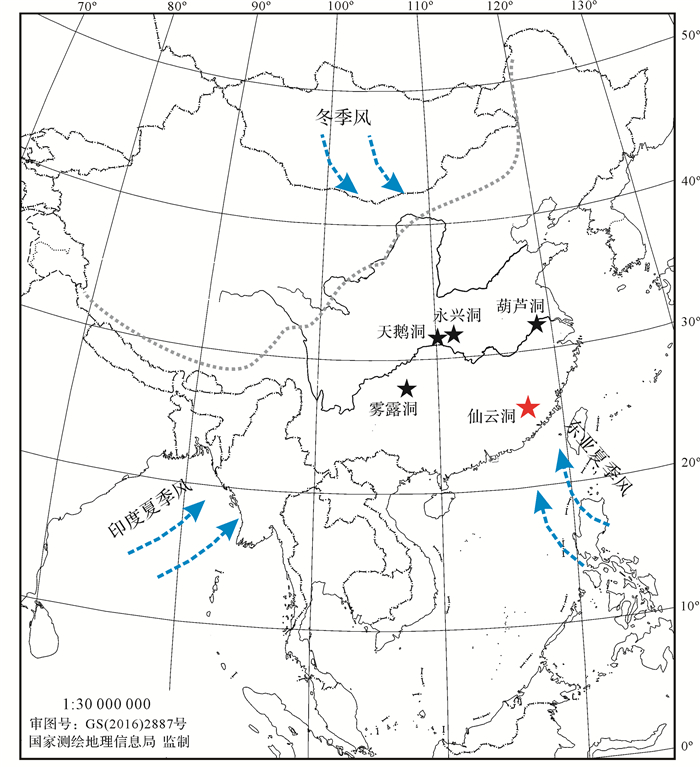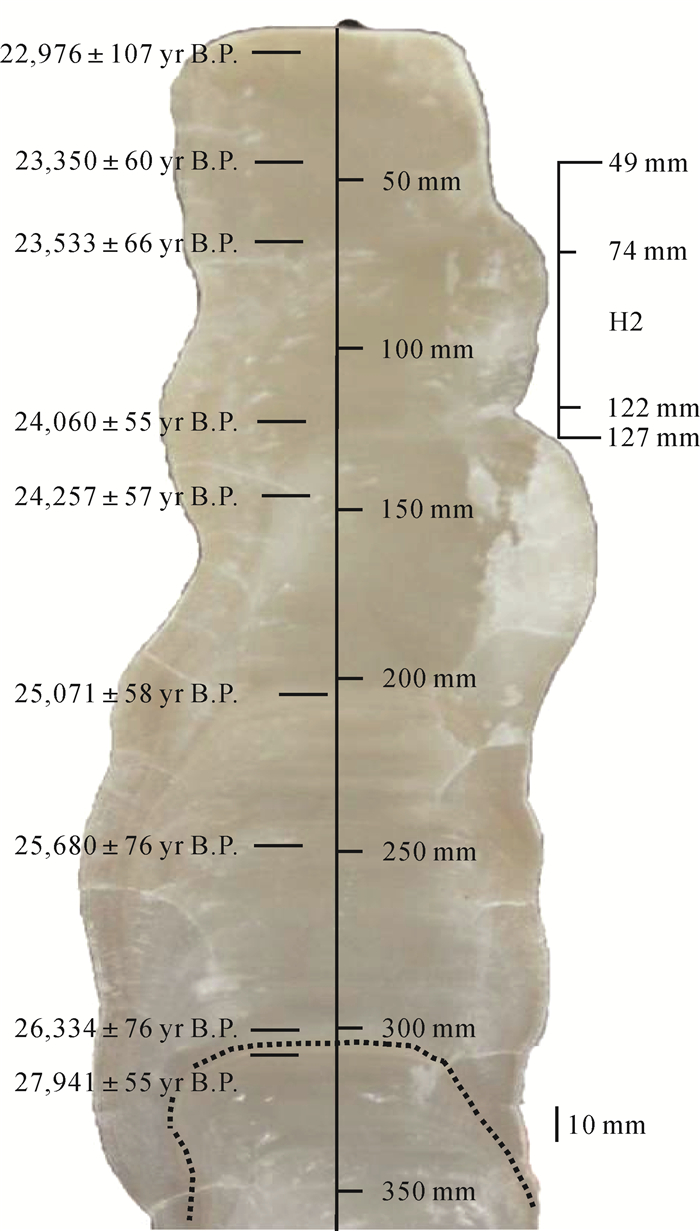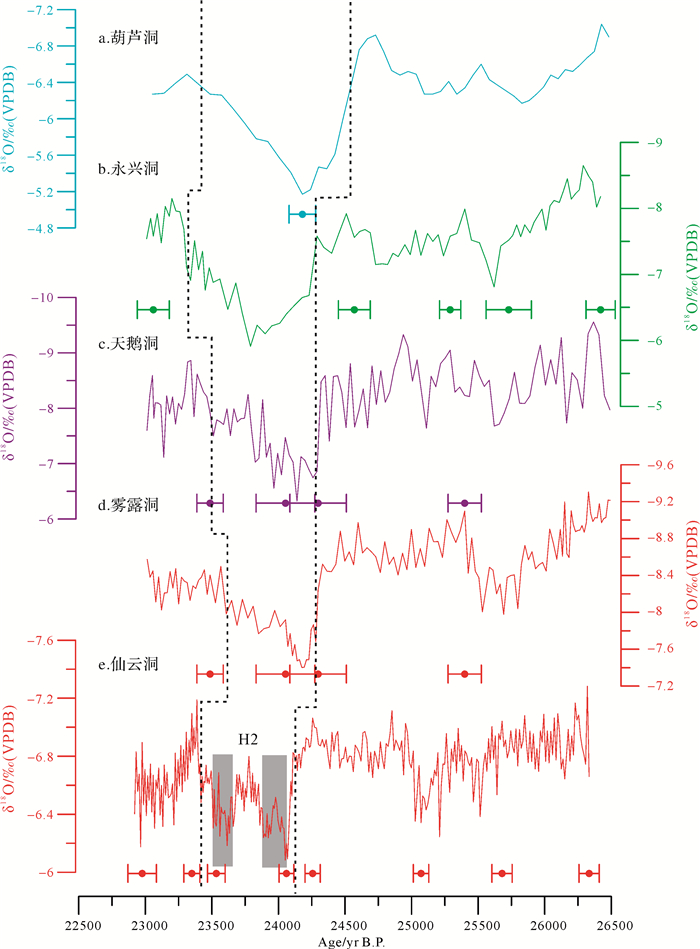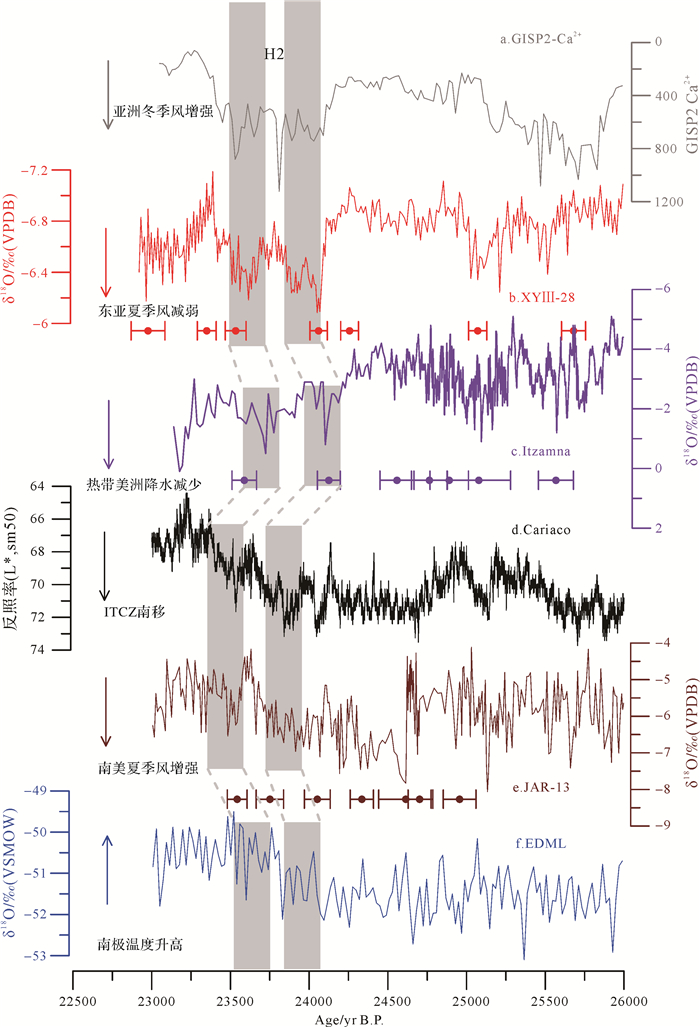
扩展功能
文章信息
- 车印平, 肖海燕, 崔梦月, 姜修洋, 蔡炳贵
- CHE YinPing, XIAO HaiYan, CUI MengYue, JIANG XiuYang, CAI BingGui
- 闽西仙云洞石笋记录的Heinrich2事件年龄及亚旋回特征
- Timing and Structure of the Heinrich 2 Abrupt Event Inferred from a Speleothem Record from Xianyun Cave, Western Fujian Province
- 沉积学报, 2018, 36(6): 1139-1147
- ACTA SEDIMENTOLOGICA SINCA, 2018, 36(6): 1139-1147
- 10.14027/j.issn.1000-0550.2018.143
-
文章历史
- 收稿日期:2018-04-23
- 收修改稿日期: 2018-06-04
2. 福建师范大学地理研究所, 福州 350007
2. Institute of Geography, Fujian Normal University, Fuzhou 350007, China
末次盛冰期(The Last Glacial Maximum,简称为LGM)是地球气候历史上的最后一个最大冰川时期[1],一直以来都是古气候研究的热点问题。Heinrich2突变事件(简称H2事件)正是形成于LGM中一次典型的陆源冰漂碎屑层事件,时间大约在25~24 kyr B.P.[2]。H2事件发生时,北大西洋深海沉积物中冰漂碎屑层比值上升[3-4],北大西洋及格陵兰地区温度下降、海冰范围增加[5-6],北大西洋经向翻转环流(AMOC)减弱[7-8],东亚夏季风(EASM)减弱[9],热带辐合带(ITCZ)向南推移[10],热带美洲降水减少[11]。与北半球变冷变干相反的是,南极变暖[12],南美夏季风增强[13-14]。尽管全球众多记录对H2事件都有记载,但受限于定年精度和样品分辨率等原因,目前对于H2事件的起止时间还存在一定差异[11]。深海沉积物由于沉积速率较慢,给出H2事件的发生时间大致在25~24 kyr B.P.[2]。高精度定年的伊比利亚半岛边缘SU818钻孔多指标解析,认为H2事件所对应的冰漂碎屑层峰值的发生时间为23.5 kyr B.P.[15]。遗憾的是,具有年层时标的格陵兰冰芯NGRIP在H2事件时δ18O记录变化特征并不明显[16]。
具有高精度U系定年的石笋记录能标定H2事件的年龄。在亚洲季风区石笋记录中,葫芦洞[9]、天鹅洞[17]、雾露洞[18-19]、万象洞[20]、羊口洞[21]、永兴洞[22]都记录了H2事件,但对H2事件的发生时间略有差异。对于H2事件内部突变过程的认识存在不同。葫芦洞石笋记录的H2事件呈现“V”型结构特征[9]。永兴洞[22]、天鹅洞[17]、雾露洞[18-19]石笋记录则表现为“突然偏正,缓慢偏负”的特征。万象洞和金湾滩洞[20]石笋记录则表现出缓慢偏正的过程。上述差异可能是由于定年精度和样品分辨率不同引起的,或者是不同气候区的气候记录载体对H2事件的响应不同。此外,陈仕涛等[17]、赵侃等[18]、吴秀平等[20]通过对比H2事件和H1事件,提出H事件内部具有复杂的亚旋回变化特征。
本文选取位于我国东南部典型东亚季风区的福建西部仙云洞一支石笋(XYⅢ-28),利用9个U/Th年龄和301个δ18O数据结果,重建了我国东南地区26.33~22.98 kyr B.P.期间平均分辨率为11 yr的东亚夏季风演化序列。通过与已有的南北半球高低纬古气候记录对比,探讨H2事件的起止时间和内部变化过程。
1 材料和方法仙云洞(116°59'E,25°33'N,海拔970 m)位于福建省连城县赖源乡(图 1),溶洞发育于二叠系栖霞组石灰岩中[23]。洞穴为三层阶状廊道式溶洞,洞穴封闭性较好,洞内实测相对湿度接近100%(2016年6—8月测)。仙云洞位于典型的湿润亚热带季风气候区,夏季高温多雨,冬季温和湿润。年平均气温为19.3 ℃,最高气温出现在7月份,最低气温出现在1月份。洞内实测温度为17.5 ℃,与洞外年均温较为接近。洞穴上覆植被为亚热带常绿阔叶林。连城县年平均降水量为1 500~1 700 mm,夏半年(4—10月)降水量超过全年降水的80%,并且该地降水δ18O受到东亚夏季风的强烈影响,夏季偏轻,冬季偏重,即当夏季风强盛时,大气降水δ18O值明显负偏,反之则偏正。

|
| 图 1 仙云洞地理位置图 红色五角星表示仙云洞位置,黑色五角星分别表示葫芦洞、永兴洞、天鹅洞和雾露洞位置;蓝色虚线箭头分别表示东亚夏季风、印度夏季风和冬季风 Figure 1 Location of Xianyun Cave The red star indicates the position of Xianyun Cave, and the black stars indicate the positions of Hulu Cave, Yongxing Cave, Swan Cave, and Wulu Cave, respectively; the blue dotted arrows indicate the East Asian summer monsoon, Indian summer monsoon and winter monsoon, respectively |
XYⅢ-28石笋采自于该洞穴底部,总长为760 mm,顶部直径约为70 mm,底部直径约为90 mm。沿着石笋生长轴切开并抛光,抛光面呈白色和透明色相间分布(图 2)。距顶部305 mm处存在一个风化层面,有可能为沉积间断。

|
| 图 2 仙云洞XYⅢ-28石笋抛光面图 黑色线段表示测年点,黑色虚线表示沉积间断,49~127 mm表示H2事件突变过程层段 Figure 2 Photo for sample XYⅢ-28 from Xianyun Cave, Southeast China The black rectangles indicate the positions of dated sub-samples. The black dotted lines instruct the positions of discontinuity. 49-127 mm represents the layer of the H2 abrupt climate changes |
选择XYⅢ-28石笋0~308 mm层段,在抛光面上,用直径0.9 mm的牙钻共取得9个石笋粉末样品用于U/Th定年,分析仪器为MC-ICP-MS Neptune,在台湾大学地质系高精度质谱与环境变迁实验室(HISPEC)测试完成,年龄分析误差为±2σ,方法参照Shen et al.[24]。沿石笋生长中轴线采用0.5 mm钻头以1 mm为平均间隔共采集301个石笋粉末样品用于氧同位素分析,采用连续流Gasbench装置与Finnigan MAT-253型质谱仪联机测试,每9个样品加测一个标准样品(NBS-19),结果以δ18O(‰,VPDB)表示,计算公式为δ18O=[(18O/16O样品)/(18O/16O标准)-1]×1 000,分析误差(±2σ)优于0.06‰,在福建师范大学同位素实验室测试完成。
2 结果 2.1 XYⅢ-28石笋在0~308 mm层段年龄模式定年结果显示,该石笋238U含量高((6.1~13)mg/L),232Th含量低((0.05~0.2) μg/L),定年精度高,均优于0.5%;在距顶部302~305 mm确为一沉积间断,石笋停止生长时间约为1.61 kyr,本文主要分析此沉积间断面以上至顶部层段(0~301 mm)。基于230Th测年线性内插和外推法,XYⅢ-28石笋沉积时段为26.33~22.98 kyr B.P.(图 3、表 1)。误差在±53~±76 yr之间,仅有一个误差较大(±107 yr)。在301~147 mm层段,生长速率为0.07 mm/yr;在147 mm以上层段,石笋生长速率相对较快,约0.11 mm/yr。

|
| 图 3 仙云洞石笋XYⅢ-28年龄—深度曲线图 误差棒表示石笋230Th测年点及测年误差(±2σ) Figure 3 XYⅢ-28 230Th dating-depth model Error bars represent the 230Th dating points and dating errors (±2σ) |
| 样品号 | 238U/(μg/L) | 232Th/(ng/L) | 230Th/238U(活度比) | δ234U(测量值) | 234U初始值(校正值) | 230Th年龄(yr,未校正值) | 230Th年龄(yr B.P.,校正值) |
| XYⅢ-28-5 | 11 584±23 | 148±9 | 0.438 2±0.001 6 | 1 259.9±5.0 | 1 344.6 ±5.3 | 23 044±107 | 22 976±107 |
| XYⅢ-28-41 | 11 270±14 | 81±7 | 0.450 7±0.000 8 | 1 289.9±3.4 | 1 378.1±3.7 | 23 417±60 | 23 350±60 |
| XYⅢ-28-65 | 11 063±16 | 73±11 | 0.453 6±0.000 8 | 1 288.5±4.1 | 1 377.2±4.4 | 23 601±66 | 23 533±66 |
| XYⅢ-28-123 | 8 008±10 | 158±10 | 0.453 9±0.000 7 | 1 245.0±3.0 | 1 332.7±3.2 | 24 128±55 | 24 060±55 |
| XYⅢ-28-147 | 13 017±16 | 129±11 | 0.458 5±0.000 7 | 1 251.0±3.2 | 1 339.9±3.4 | 24 324±57 | 24 257±57 |
| XYⅢ-28-203 | 6 171±18 | 201±9 | 0.476 1±0.000 8 | 1 268.2±2.9 | 1 361.4±3.2 | 25 139±58 | 25 071±58 |
| XYⅢ-28-250 | 11 920±18 | 78±9 | 0.486 1±0.001 0 | 1 266.2±3.8 | 1 361.7±4.1 | 25 747±76 | 25 680±76 |
| XYⅢ-28-300 | 9 815±15 | 143±8 | 0.498 7±0.000 9 | 1 272.5±4.1 | 1 370.9±4.4 | 26 401±76 | 26 334±76 |
| XYⅢ-28-308 | 11 702±12 | 52±11 | 0.527 4±0.000 7 | 1 278.6±2.6 | 1 383.8±2.8 | 28 008±55 | 27 941±55 |
| 注:λ230=9.157 7×10-6 yr-1;λ234=2.826 3×10-6 yr-1;λ238=1.551 25×10-10 yr-1;δ234U=[(234U/238U)活度比-1]×1 000;δ234U初始值是根据铀钍年龄获得,即δ234U初始值=δ234U测量值×eλ234×T;校正铀钍年龄假设初始的230Th/232Th原子比为(4±2)×10-6。yr B.P.为相对于公元1950年。 | |||||||
XYⅢ-28石笋在0~301 mm层段的δ18O记录随时间变化序列如图 4所示,平均分辨率为11 yr。在26.33~24.09 kyr B.P.时段,石笋δ18O整体相对偏负,在-6.2‰~-7.3‰之间波动,平均值为-6.8‰;在24.09~23.39 kyr B.P.时期,石笋δ18O快速正偏,变化范围为-6.1‰~-6.8‰,振幅达0.7‰,为H2突变事件,内部表现为“两谷一峰”特征;在23.39~22.92 kyr B.P.时段,石笋δ18O整体相对偏负,在-6.2‰~-7.1‰之间波动,平均值为-6.7‰。

|
| 图 4 H2事件突变阶段不同洞穴记录对比 a.葫芦洞δ18O记录[9];b.永兴洞δ18O记录[22];c.天鹅洞δ18O记录[17];d.雾露洞δ18O记录[18-19];e.仙云洞δ18O记录;不同颜色误差棒为石笋记录的测年点及误差(±2σ);虚线表示各记录H2事件开始和结束;灰色矩形框为H2事件内部的百年至十年尺度弱季风事件 Figure 4 Comparison of δ18O records of different caves in Heinrich Event 2 a. Hulu δ18O record; b.Yongxing δ18O record; c. Swan δ18O record; d. Wulu δ18O record; e.Xianyun δ18O record (this study). 230Th ages and errors are color-coded by cave. The dotted lines indicate the onset and end in H2; the gray bars represents centenary-decade scale event of the internal H2 |
近20年的石笋研究表明,亚洲季风区石笋δ18O所指示的气候意义各有不同。主要存在以下几种认识:1)石笋δ18O记录表示冬/夏降水比率变化[9];2)指代热带印度洋—太平洋和洞穴地点之间气团在运移过程的水汽剩余比[25];3)反映受控于亚洲季风强度变化的大气降水量变化[26-27];4)指代印度季风强度变化而不是东亚季风降水量[28];5)石笋δ18O记录反映的不是季风降水量变化,而是水汽源变化[29];6)石笋δ18O记录主要反映了远近水汽源份额变化,即“环流效应”[30]。
尽管存在上述争议,但东亚季风区内各洞穴石笋δ18O记录在轨道—千年尺度具有大范围的区域一致性,说明该区石笋δ18O记录最可能是反映夏季风强度[31-32],具有全球性意义。最近,Cheng et al.[33]指出东亚季风区石笋δ18O值的变化一般指示平均气候状态下夏季风强度变化,即δ18O值偏正指示夏季风减弱,反之则相反。此解释也得到模型研究结果的支持[34]。与已发表的东亚季风区葫芦洞[9]、永兴洞[22]、天鹅洞[17]、雾露洞[18-19]石笋δ18O记录比较发现,该区域各洞穴石笋δ18O记录在H2事件上表现出整体一致的偏正特征。仙云洞与葫芦洞、永兴洞、天鹅洞、雾露洞石笋δ18O记录整体一致的证据说明,同位于东亚季风区的仙云洞石笋δ18O记录在千年尺度气候事件上指示了季风强度变化,即季风越强,石笋δ18O越偏负,反之则偏正。
3.2 H2事件年龄东亚季风区石笋记录在H2时段具有整体一致性,表明东亚季风区石笋记录响应于共同的驱动因素,但在细节上还有一定的差异。已发表的葫芦洞[9]、永兴洞[22]、天鹅洞[17]和雾露洞[18-19]记录分别在24.5~23.5 kyr B.P.、24.3~23.3 kyr B.P.、24.3~23.5 kyr B.P.和24.3~23.6 kyr B.P.明显偏正,持续时间分别约为1.0 kyr、1.0 kyr、0.8 kyr和0.7 kyr,对应于H2突变事件(图 4)。永兴洞、天鹅洞和雾露洞记录开始时间相同,表现为突变开始的特征;葫芦洞记录比其他洞穴记录开始时间早约200 yr,持续时间比天鹅洞和雾露洞记录明显更长。如图 4所示,在H2事件期间及前后时段,葫芦洞石笋记录仅有1个定年点,测年误差为±100 yr;永兴洞石笋记录提供有2个定年点,测年误差为±120 yr;天鹅洞记录提供了3个定年点,测年误差在±220~±335 yr之间,平均误差为±278 yr,定年误差相对较大;雾露洞记录有3个定年点,误差在±99~±221 yr之间,平均误差为±186 yr。在测年误差范围内,已有的亚洲季风区石笋记录由于定年精度和样品分辨率不同,使得H2事件的起止时间和持续时间仍有一定差异。
本文重建的高分辨率仙云洞石笋δ18O记录在24.09~23.39 kyr B.P.时段整体正偏,振幅为0.7‰,对应于H2突变事件。仙云洞记录在H2事件的起止时间上分别提供了2个定年点,误差在±55~±66 yr之间,平均误差约为±60 yr,测年误差较小。根据突变事件主要变化过程中间点的位置可以标定仙云洞石笋记录H2事件的起止时间分别为24.09±0.06 kyr B.P.、23.39±0.07 kyr B.P.,持续时间为0.69±0.06 kyr。因此,我们认为具有高精度定年和高分辨率的仙云洞石笋记录更为精确的标定了H2突变事件。
3.3 H2事件亚旋回特征在H2事件期间,高分辨率的仙云洞石笋δ18O记录整体呈现出“两谷一峰”结构(图 4)。在24.09~23.87 kyr B.P.时期,石笋δ18O值平均值为-6.3‰,相对整体偏正,为H2事件内部的百年至十年尺度的弱季风事件;在23.87~23.64 kyr B.P.时段,石笋δ18O值平均值为-6.6‰,相对整体偏负,为H2事件内部的百年至十年尺度的强季风事件;在23.64~23.50 kyr B.P.时期,石笋δ18O值平均值为-6.4‰,相对整体偏正,为H2事件内部的百年至十年尺度的弱季风事件。
由图 4可见,H2事件期间的这种亚旋回特征在雾露洞也略有体现,但并不如仙云洞石笋记录清晰。天鹅洞石笋记录则在H2事件内部呈现波动振荡的亚旋回特征。永兴洞和葫芦洞由于样品分辨率的原因,没有记录到这些亚旋回事件。研究发现,仙云洞石笋记录H2事件内部的百年至十年际尺度的气候振荡特征在H1事件[35-36]、新仙女木事件[37-39]以及小冰期[40-43]也同样存在。这说明,在这些千年尺度极端变冷事件的内部也是不稳定的。前人研究表明,这种千年尺度气候极端变冷事件内部百年至十年尺度不稳定的气候事件有可能是在太阳活动的影响下[35, 37-38],使得北大西洋海冰异常、ITCZ南北移动[10]、全球大气环流重组[44]、低纬度大气环流显著变化[9]、亚洲季风区水文变化异常[45],从而使得这些千年尺度事件内部呈现出不稳定的变化特征。
3.4 高低纬记录对比先前的研究已表明,H2事件具有全球性特征,南北半球气候呈现“see-saw”模式[13, 46-47]。在百年至十年际尺度上,这种“see-saw”模式依然存在。格陵兰冰芯GISP2 Ca2+(图 5a)[16]具有仙云洞石笋记录(图 5b)类似地亚旋回特征。已有研究表明,格陵兰冰芯GISP2 Ca2+在百年至十年尺度上指示了亚洲冬季风强度[18]。仙云洞石笋记录与格陵兰冰芯GISP2 Ca2+在百年至十年际尺度上具有很好的关联性,即石笋δ18O增加对应于Ca2+离子浓度增加,反之则相反。这也说明在H2期间,东亚夏季风和冬季风呈反相位关系。仙云洞石笋记录的H2事件期间2个百年至十年际尺度的弱季风事件同样体现在反映热带美洲地区降水变化的高分辨率墨西哥石笋Itzamna记录中(图 5c),在23.7 kyr B.P.、24.1 kyr B.P.时期2个百年至十年际尺度的降水减弱事件[11],与仙云洞石笋记录的弱季风事件具有一致性。同时,指代ITCZ位置变化的Cariaco盆地反照率记录(图 5d)显示,ITCZ向南移动[10],反映南美季风系统(SAMS)的高分辨率巴西南部石笋JAR-13 δ18O记录(图 5e)在23.6 kyr B.P.前后则出现两个偏负过程,南美夏季风增强[14]。南极冰芯EDML δ18O记录(图 5f)显示,在H2期间呈现两个阶段的温度升高过程[12]。南北半球高分辨率古气候记录表现为反相位特征,即“see-saw”模式。这种模式有可能是AMOC通过改变ITCZ位置和大气环流来调节东亚季风和南美季风所形成的[47]:当AMOC偏强时,ITCZ位置北移,东亚夏季风环流增强,降水增多;此时,SAMS也随之北移,南美夏季风偏弱,巴西南部则降水减少。反之,当AMOC偏弱时,ITCZ位置南移,南美夏季风偏强,巴西南部降水增多,东亚夏季风则偏弱,降水减少。

|
| 图 5 仙云洞石笋δ18O与高低纬气候记录对比 a.格陵兰GISP2 Ca2+记录[16];b.仙云洞δ18O记录;c.墨西哥石笋δ18O记录[11];d. Cariaco盆地反照率记录[10];e.巴西石笋δ18O记录[14];f.南极冰芯EDML δ18O记录[12];不同颜色误差棒为石笋的测年点及误差(±2σ);灰色矩形框为H2事件内部的百年至十年尺度弱季风事件 Figure 5 Comparison of δ18O records for Xianyun Cave and high-low latitude climate records a. GISP2 Ca2+ record; b. XYⅢ-28 δ18O record (this study); c. Itzamna δ18O record; d. sediment reflectance record from the Cariaco Basin; e. JAR-13 δ18O record; f. EDML δ18O record; 230Th ages and errors are color-coded by cave; the gray bars represents centenary-decade scale event of the internal H2 |
(1) 基于福建西部仙云洞石笋(XYⅢ-28)9个U/Th年龄和301个氧同位素结果,建立了26.33~22.98 kyr B.P.期间平均分辨率为11 yr的东亚夏季风演化序列。石笋δ18O记录最为显著的特征在24.09~23.39 kyr B.P.时段偏正,振幅为0.7‰,对应于北大西洋显著的H2突变事件。根据主要变化过程中间点的位置可以标定H2事件的起止时间分别为24.09±0.06 kyr B.P.、23.39±0.07 kyr B.P.,H2事件的持续时间为0.69±0.06 kyr。
(2) XYⅢ-28石笋记录在H2事件内部呈现出非常明显的百年至十年尺度“两谷一峰”结构的亚旋回特征,这种亚旋回特征在H1事件、新仙女木事件以及小冰期等内部同样存在,表明这些千年尺度极端变冷事件的内部气候变化也是不稳定的。仙云洞石笋记录与高低纬古气候记录对比发现,H2时期南北半球呈现反相位关系,即“see-saw”模式。
致谢 感谢台湾大学沈川洲教授在定年上提供的帮助。
| [1] |
Clark P U, Dyke A S, Shakun J D, et al. The last glacial maximum[J]. Science, 2009, 325(5941): 710-714. DOI:10.1126/science.1172873 |
| [2] |
Heinrich H. Origin and consequences of cyclic ice rafting in the Northeast Atlantic Ocean during the past 130, 000 years[J]. Quaternary Research, 1988, 29(2): 142-152. DOI:10.1016/0033-5894(88)90057-9 |
| [3] |
Bond G C, Showewrs W J, Cheseby M, et al. A pervasive millennial-scale cycle in the North Atlantic Holocence and glacial climates[J]. Science, 1997, 278(7): 1257-1265. |
| [4] |
Eynaud F, De Abreu L, Voelker A, et al. Position of the Polar Front along the western Iberian margin during key cold episodes of the last 45 ka[J]. Geochemistry, Geophysics, Geosystems, 2009, 10(7): 131-147. |
| [5] |
Broecker W S. Massive iceberg discharges as triggers for global climate change[J]. Nature, 1994, 372(6505): 421-424. DOI:10.1038/372421a0 |
| [6] |
Grousset F E, Pujol C, Labeyrie L, et al. Were the North Atlantic Heinrich events triggered by the behavior of the European ice sheets?[J]. Geology, 2000, 28(28): 123-126. |
| [7] |
McManus J F, Francois R, Gherardi J M, et al. Collapse and rapid resumption of Atlantic meridional circulation linked to deglacial climate changes[J]. Nature, 2004, 428(6985): 834-837. DOI:10.1038/nature02494 |
| [8] |
Campos M C, Chiessi C M, Voigt I, et al. δ13C decreases in the upper western South Atlantic during Heinrich Stadials 3 and 2[J]. Climate of the Past, 2017, 13(4): 348-359. |
| [9] |
Wang Y J, Cheng H, Edwards R L, et al. A high-resolution absolute-dated Late Pleistocene monsoon record from Hulu Cave, China[J]. Science, 2001, 294(5550): 2345-2348. DOI:10.1126/science.1064618 |
| [10] |
Deplazes G, Lückge A, Peterson L C, et al. Links between tropical rainfall and North Atlantic climate during the last glacial period[J]. Nature Geoscience, 2013, 6(3): 213-217. DOI:10.1038/ngeo1712 |
| [11] |
Medina-Elizalde M, Burns S J, Polanco-martínez J, et al. Synchronous precipitation reduction in the American Tropics associated with Heinrich 2[J]. Scientific Reports, 2017, 7(1): 11216. DOI:10.1038/s41598-017-11742-8 |
| [12] |
Members E C. Stable oxygen isotopes of ice core EDML[J]. Pangaea, 2010. DOI:10.1594/PANGAEA.754444 |
| [13] |
Wang X F, Edwards R L, Auler A S, et al. Hydroclimate changes across the Amazon lowlands over the past 45, 000 years[J]. Nature, 2017, 541(7636): 204-207. DOI:10.1038/nature20787 |
| [14] |
Novello V F, Cruz F W, Vuille M, et al. A high-resolution history of the South American Monsoon from Last Glacial Maximum to the Holocene[J]. Scientific Reports, 2017, 7: 44267. DOI:10.1038/srep44267 |
| [15] |
Bard E, Rostek F, Turon J L, et al. Hydrological impact of heinrich events in the subtropical northeast Atlantic[J]. Science, 2000, 289(5483): 1321-1324. DOI:10.1126/science.289.5483.1321 |
| [16] |
Rasmussen S O, Seierstad I K, Andersen K K, et al. Synchronization of the NGRIP, GRIP, and GISP2 ice cores across MIS 2 and palaeoclimatic implications[J]. Quaternary Science Reviews, 2008, 27(1/2): 18-28. |
| [17] |
陈仕涛, 汪永进, 吴江滢, 等. 东亚季风气候对Heinrich2事件的响应:来自石笋的高分辨率记录[J]. 地球化学, 2006, 35(6): 586-592. [ Chen Shitao, Wang Yongjin, Wu Jiangying, et al. An event of the East Asian monsoon responding to Heinrich Event 2:evidence from high-resolution stalagmite record[J]. Geochimica, 2006, 35(6): 586-592. DOI:10.3321/j.issn:0379-1726.2006.06.002] |
| [18] |
赵侃, 汪永进. 黔西南石笋记录MIS3/2阶段百年尺度季风演变和H事件特征[J]. 海洋地质与第四纪地质, 2011, 31(2): 121-128. [ Zhao Kan, Wang Yongjin. Asian Monsoon changes on centennial-scale and characters of Heinrich events during the MIS 3/2 transition from a stalagmite record in southwest China[J]. Marine Geology & Quaternary Geology, 2011, 31(2): 121-128.] |
| [19] |
Zhao K, Wang Y J, Edwards R L, et al. High-resolution stalagmite δ18O records of Asian monsoon changes in central and southern China spanning the MIS 3/2 transition[J]. Earth and Planetary Science Letters, 2010, 298(1/2): 191-198. |
| [20] |
吴秀平, 吴锦奎, 侯典炯, 等. 黄土高原西部石笋记录的H2事件特征[J]. 地球科学——中国地质大学学报, 2013, 38(3): 471-481. [ Wu Xiuping, Wu Jinkui, Hou Dianjiong, et al. Characteristics and variability of Heinrich-2 event recorded by stalagmite oxygen isotopic composition in the western Loess Plateau[J]. Earth Sciences-Journal of China University of Geosciences, 2013, 38(3): 471-481.] |
| [21] |
袁娜.重庆羊口洞石笋记录的Heinrich事件[D].重庆: 西南大学, 2015. [Yuan Na. The Heinrich events during the period recorded by the stalagmites in Yangkou Cave, Chongqing[D]. Chongqing: Southwest University, 2015.]
|
| [22] |
Chen S, Wang Y, Cheng H, et al. Strong coupling of Asian Monsoon and Antarctic climates on sub-orbital timescales[J]. Scientific Reports, 2016, 6: 32995. DOI:10.1038/srep32995 |
| [23] |
张富强, 李苗发, 曹奇, 等. 闽西仙云洞空间结构特征及其影响因素浅析[J]. 亚热带资源与环境学报, 2018, 13(1): 88-94. [ Zhang Fuqiang, Li Miaofa, Cao Qi, et al. Spatial structure and influencing factors of the Xianyun Cave in western Fujian province[J]. Journal of Subtropical Resources and Environment, 2018, 13(1): 88-94. DOI:10.3969/j.issn.1673-7105.2018.01.013] |
| [24] |
Shen C C, Cheng H, Edwards R L, et al. Measurement of attogram quantities of 231Pa in dissolved and particulate fractions of seawater by isotope dilution thermal ionization mass spectroscopy[J]. Analytical Chemistry, 2003, 75(5): 1075-1079. DOI:10.1021/ac026247r |
| [25] |
Yuan D X, Cheng H, Edwards R L, et al. Timing, duration, and transitions of the Last Interglacial Asian monsoon[J]. Science, 2004, 304(5670): 575-578. DOI:10.1126/science.1091220 |
| [26] |
Zhang P Z, Cheng H, Edwards R L, et al. A test of climate, sun, and culture relationships from an 1810-year Chinese cave record[J]. Science, 2008, 322(5903): 940-942. DOI:10.1126/science.1163965 |
| [27] |
Tan L C, Cai Y J, Cheng H, et al. Centennial-to decadal-scale monsoon precipitation variations in the upper Hanjiang River region, China over the past 6650 years[J]. Earth and Planetary Science Letters, 2018, 482: 580-590. DOI:10.1016/j.epsl.2017.11.044 |
| [28] |
Pausata F S R, Battisti D S, Nisancioglu K H, et al. Chinese stalagmite δ18O controlled by changes in the Indian monsoon during a simulated Heinrich event[J]. Nature Geoscience, 2011, 4(7): 474-480. DOI:10.1038/ngeo1169 |
| [29] |
Maher B A. Holocene variability of the East Asian summer monsoon from Chinese cave records:a re-assessment[J]. Holocene, 2008, 18(18): 861-866. |
| [30] |
谭明. 环流效应:中国季风区石笋氧同位素短尺度变化的气候意义-古气候记录与现代气候研究的一次对话[J]. 第四纪研究, 2009, 29(5): 851-862. [ Tan Ming. Circulation effect:climatic significance of the short term variability of the oxygen isotopes in stalagmites from monsoonal China-dialogue between paleoclimate records and modern climate research[J]. Quaternary Sciences, 2009, 29(5): 851-862. DOI:10.3969/j.issn.1001-7410.2009.05.01] |
| [31] |
程海, 艾思本, 王先锋, 等. 中国南方石笋氧同位素记录的重要意义[J]. 第四纪研究, 2005, 25(2): 157-163. [ Cheng Hai, Edwards R L, Wang Xianfeng, et al. Oxygen isotope records of stalagmites from southern China[J]. Quaternary Sciences, 2005, 25(2): 157-163. DOI:10.3321/j.issn:1001-7410.2005.02.004] |
| [32] |
Cheng H, Edwards R L, Sinha A, et al. The Asian monsoon over the past 640, 000 years and ice age terminations[J]. Nature, 2016, 534(7609): 640-646. DOI:10.1038/nature18591 |
| [33] |
Cheng H, Sinha A, Wang X F, et al. The Global Paleomonsoon as seen through speleothem records from Asia and the Americas[J]. Climate Dynamics, 2012, 39(5): 1045-1062. DOI:10.1007/s00382-012-1363-7 |
| [34] |
Liu Z Y, Wen X Y, Brady E C, et al. Chinese cave records and the East Asia Summer Monsoon[J]. Quaternary Science Reviews, 2014, 83: 115-128. DOI:10.1016/j.quascirev.2013.10.021 |
| [35] |
汪永进, 吴江滢, 刘殿兵, 等. 石笋记录的东亚季风气候H1事件突变性特征[J]. 中国科学(D辑):地球科学, 2002, 32(3): 227-233. [ Wang Yongjin, Wu Jiangying, Liu Dianbing, et al. The characteristics of H1 event mutation of East Asian monsoon recorded by stalagmites[J]. Science China(Seri.D):Earth Sciences, 2002, 32(3): 227-233.] |
| [36] |
任小凤.豫西H1事件高分辨率气候变化的多指标石笋记录及洞穴监测研究[D].重庆: 西南大学, 2015. [Ren Xiaofeng. A high-resolution climate changes during H1 event based on multi-proxy stalagmite records and cave monitoring in western Henan, China[D]. Chongqing: Southwest University, 2015.]
|
| [37] |
Ma Z B, Cheng H, Tan M, et al. Timing and structure of the Younger Dryas event in northern China[J]. Quaternary Science Reviews, 2012, 41: 83-93. DOI:10.1016/j.quascirev.2012.03.006 |
| [38] |
Liu D B, Wang Y L, Cheng H, et al. Centennial-scale Asian Monsoon variability during the mid-Younger Dryas from Qingtian Cave, central China[J]. Quaternary Research, 2013, 80(2): 199-206. DOI:10.1016/j.yqres.2013.06.009 |
| [39] |
王璐瑶, 赵侃, 黄伟, 等. 新仙女木事件内部百年尺度弱季风事件的龙腑宫洞石笋记录[J]. 南京师大学报(自然科学版), 2017, 40(1): 134-143. [ Wang Luyao, Zhao Kan, Huang Wei, et al. Centennial-scale monsoon failure during the Younger Dryas event record in a high-resolution stalagmite from Longfugong cave, central China[J]. Journal of Nanjing Normal University (Natural Science Edition), 2017, 40(1): 134-143. DOI:10.3969/j.issn.1001-4616.2017.01.020] |
| [40] |
Wang Y J, Cheng H, Edwards R L, et al. The Holocene Asian monsoon:links to solar changes and North Atlantic climate[J]. Science, 2005, 308(5723): 854-857. DOI:10.1126/science.1106296 |
| [41] |
Hu C Y, Henderson G M, Huang J H, et al. Quantification of Holocene Asian monsoon rainfall from spatially separated cave records[J]. Earth and Planetary Science Letters, 2008, 266(3/4): 221-232. |
| [42] |
姜修洋, 李志忠, 李金全, 等. 最近500年来福建玉华洞石笋氧同位素记录及气候意义[J]. 地理科学, 2012, 32(2): 207-212. [ Jiang Xiuyang, Li Zhizhong, Li Jinquan, et al. Stalagmite δ18O Record from Yuhua Cave over the past 500 Years and its regional climate significance[J]. Scientia Geographica Sinica, 2012, 32(2): 207-212.] |
| [43] |
杨勋林, 陈发虎, 袁道先, 等. 高分辨率石笋记录的三峡库区小冰期气候变化[J]. 地理科学, 2013, 33(5): 629-634. [ Yang Xunlin, Chen Fahu, Yuan Daoxian, et al. Climate change during Little Ice Age with high-resolution stalagmite record in the Three-Gorges Reservoir Area[J]. Scientia Geographica Sinica, 2013, 33(5): 629-634.] |
| [44] |
Lynch-Stieglitz J, Schmidt M W, Gene H L. Muted change in Atlantic overturning circulation over some glacial-aged Heinrich events[J]. Nature Geoscience, 2014, 7(2): 144-150. DOI:10.1038/ngeo2045 |
| [45] |
赵平, 陈军明, 肖栋, 等. 夏季亚洲-太平洋涛动与大气环流和季风降水[J]. 气象学报, 2008, 66(5): 716-729. [ Zhao Ping, Chen Junming, Xiao Dong, et al. Summer Asian-Pacific Oscillation and its relationship with atmospheric circulation and monsoon rainfall[J]. Acta Meteorologica Sinica, 2008, 66(5): 716-729. DOI:10.3321/j.issn:0577-6619.2008.05.006] |
| [46] |
Kanner L C, Burns S J, Cheng H, et al. High-latitude forcing of the South American summer monsoon during the Last Glacial[J]. Science, 2012, 335(6068): 570-573. DOI:10.1126/science.1213397 |
| [47] |
Wang X F, Auler A S, Edwards R L, et al. Millennial-scale precipitation changes in southern Brazil over the past 90, 000 years[J]. Geophysical Research Letters, 2007, 34(23): L23701. |
 2018, Vol. 36
2018, Vol. 36




